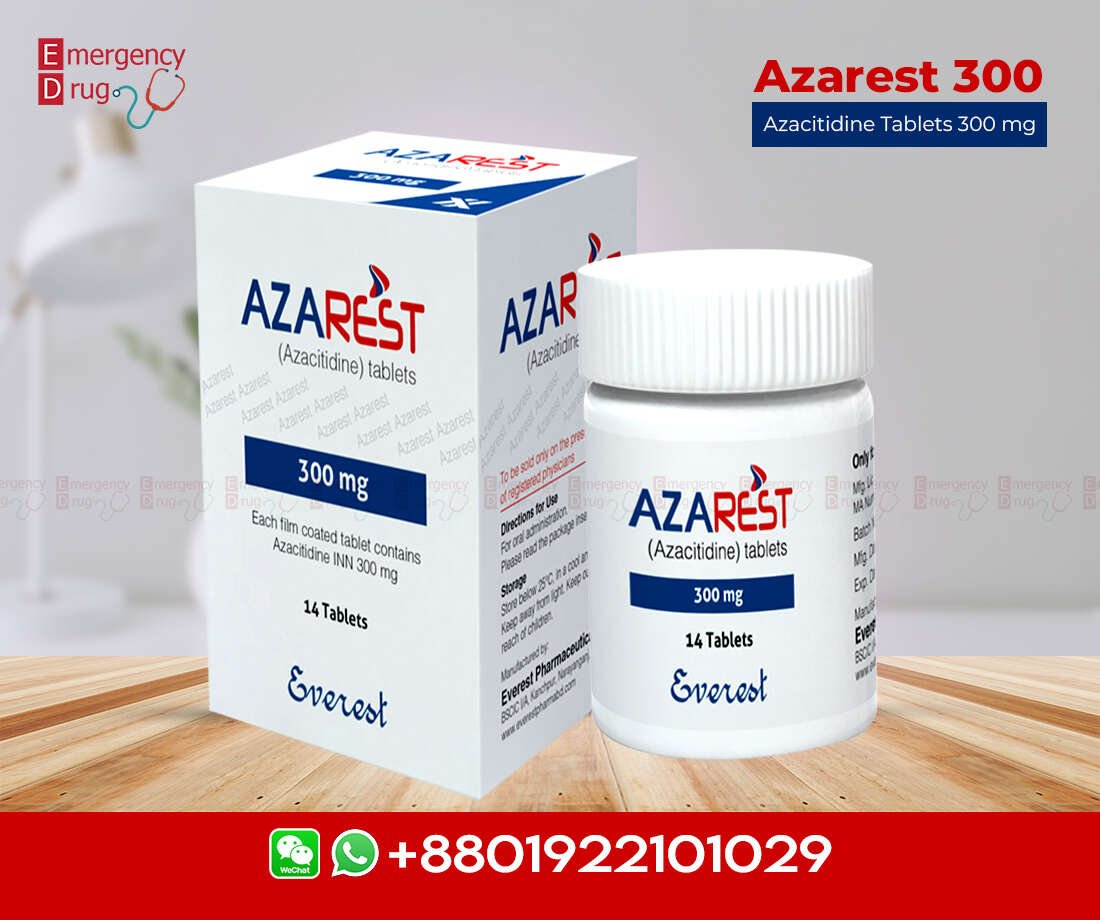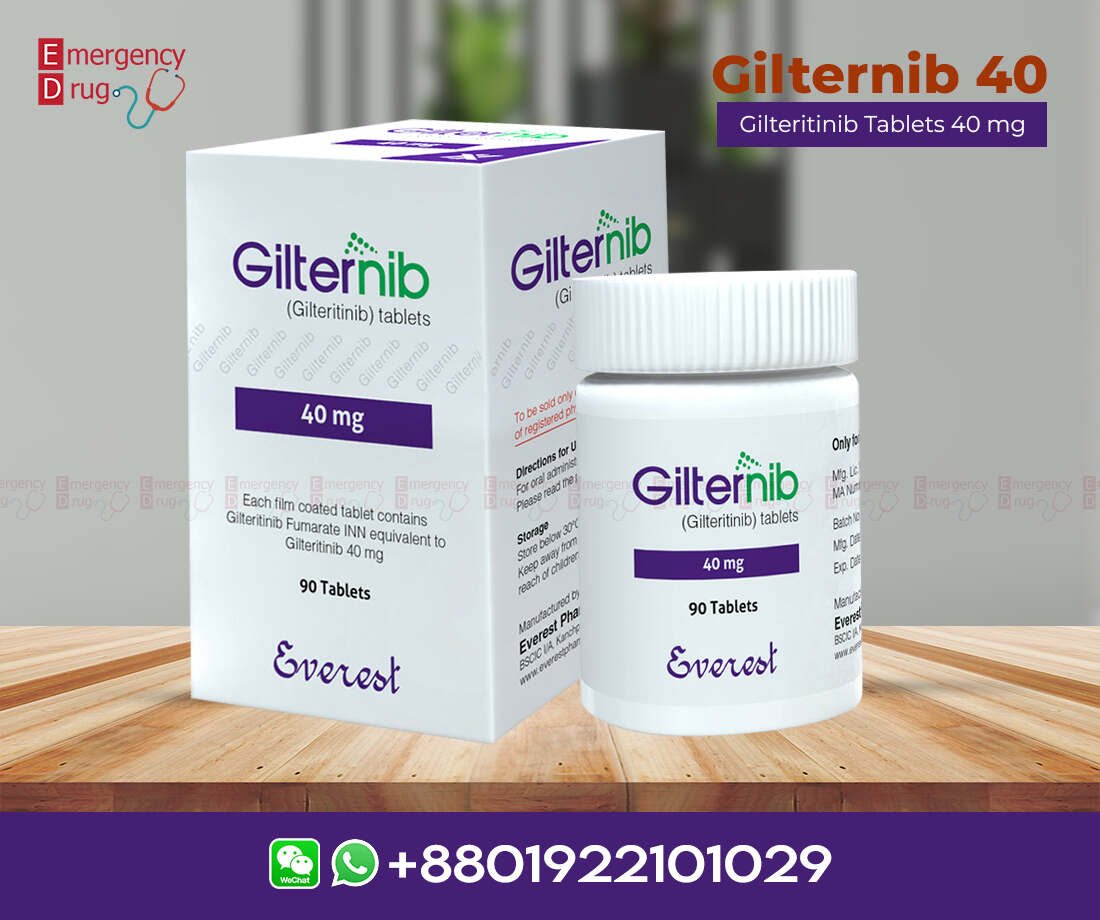Description
What is Azarest 300 mg?
Azarest 300 mg belongs to a class of antineoplastic agents. Unlike traditional chemotherapy that indiscriminately destroys both normal and abnormal cells, Azacitidine works on a cellular and genetic level to restore normal function in bone marrow.
It helps in:
- Promoting the maturation of bone marrow cells
- Controlling uncontrolled cell growth
- Improving blood cell counts
How It Works?
Azacitidine is a nucleoside analogue that inhibits DNA methyltransferase, which causes DNA hypomethylation and can lead to activation of tumor-suppressor genes. It also has cytotoxic effects on abnormal hematopoietic cells.
Azarest tablet: Each film coated tablet contains Azacitidine INN 300 mg.
Uses, Mechanism, and Benefits
Azarest 300 mg is an oral chemotherapy medicine containing Azacitidine, widely prescribed for the treatment of blood cancers, including:
- Acute Myeloid Leukemia (AML)
- Myelodysplastic Syndromes (MDS)
This medication provides a targeted therapeutic approach, offering improved survival rates and better quality of life for patients dealing with these complex hematological disorders.
Product Features
| Product Name | : | Azarest |
| Generic Name | : | Azacitidine |
| Formulation | : | Tablet |
| Available Pack Size | : | 14’s Pot |
| Available Strength | : | 300 mg |
| Registrations | : | Export Only |
Azarest 300 mg Price : $145.00
Indications
Azarest 300 mg (Azacitidine) is used to keep treating adult patients with acute myeloid leukemia who:
- Reached first complete remission (CR) or complete remission with incomplete blood count recovery (CRi) after intense initial chemotherapy.
- Can’t finish intense curative therapy.
- Chronic myelomonocytic leukemia (CMML) may also be an indication.
- Myelodysplastic syndromes (MDS), in its various subtypes (e.g. refractory anemia, excess blasts, etc.).
Azacitidine Mechanism of Action
Azacitidine 300 mg drug works like a mimic of cytidine, a building block of DNA and RNA. It stops certain enzymes in the body from adding methyl groups to DNA and RNA. When cells take in Azarest and transform it with enzymes, it becomes part of the DNA and RNA molecules. This incorporation into DNA of cancer cells, like those in acute myeloid leukemia, blocks the action of DNA methyltransferases.
This leads to less DNA methylation and changes how genes work. Some genes that help control tumors and cell development start working again. When Azacitidine becomes part of RNA in cancer cells, it also blocks the action of RNA methyltransferases. This leads to less RNA methylation, making RNA less stable and reducing protein production.
In lab studies, Azacitidine added to the DNA of cancer cells, especially those in acute myeloid leukemia, caused cell death and made cells self-destruct. This effect was also seen in living animals with leukemia tumors treated with Azarest. It reduced tumor size and helped the animals live longer.
Absorption
When you take Azacitidine by mouth, about 11% of it ends up in your bloodstream compared to when it’s given under the skin. It takes around 1 hour for Azacitidine to reach its highest level in the blood after you take it.
Dosage and Administration
- Don’t switch Azacitidine with the intravenous or subcutaneous forms. The reasons you take them and how much you take are different.
- For the first 14 days of a 28-day cycle, take 300 mg of azacitidine orally every day. It can be taken with or without meals. Continue using azacitidine unless you notice serious side effects or your illness worsens. Take an anti-nausea medication half an hour before each dose during the first two cycles. You can forgo taking the anti-nausea medication in subsequent cycles if you haven’t experienced nausea or vomiting during the first two.
- Avoid taking Azacitidine if your blood test results on Day 1 of a cycle indicate a low absolute neutrophil count (ANC) of less than 0.5 Gi/L. To begin the cycle, wait until your ANC is 0.5 Gi/L or greater.
- Some antiemetic (nausea/vomiting prevention) may be given 30 minutes before each dose in the first two cycles. If tolerated well, might be omitted later.
- Tablets must be swallowed whole — not crushed, split, or chewed.
Instruction to follow
Patients should be advised not to split, crush, or chew Azacitidine tablets. Take a dose every day at roughly the same time. Azarest should be taken as soon as possible on the same day if it is missed or not taken at the scheduled time. Then, follow your regular routine the next day.
Avoid taking two doses on the same day; if a dose causes vomiting, avoid taking another one on the same day. Go back to your regular schedule the next day. Azacitidine is a medication with risks. Observe the relevant special handling and disposal guidelines.
Monitoring & Safety / Warnings
-
Frequent monitoring of complete blood counts (CBC) especially early in therapy or after any dose changes, because of risk of myelosuppression (low neutrophils, platelets, etc.).
- Do not start a new cycle if the absolute neutrophil count (ANC) is < 0.5 ×10⁹/L on Day 1. Wait until recovery.
- Avoid handling if pregnant or potentially pregnant — it may cause fetal harm. Women of childbearing potential should use effective contraception.
Azacitidine side effects
Clinical Trials Experience
- Serious Reactions: About 15% of patients had serious side effects, such as pneumonia and febrile neutropenia (low white blood cell count with fever). One patient died due to sepsis.
- Discontinuation: 8% stopped taking Azarest because of side effects like nausea, diarrhea, and vomiting.
- Interruptions: 35% had to pause treatment due to side effects, mainly neutropenia (low white blood cell count), thrombocytopenia (low platelet count), and nausea.
- Dose Reductions: 14% had their dose reduced because of side effects, mainly for neutropenia, diarrhea, thrombocytopenia, and nausea.
- Common Side Effects: Nausea, vomiting, diarrhea, fatigue, constipation, pneumonia, abdominal pain, joint pain, decreased appetite, febrile neutropenia, dizziness, and limb pain were the most frequent side effects, each affecting over 10% of patients.
Post-marketing Experience
Some adverse reactions reported after approval include hypersensitivity reactions, lung problems, tumor lysis syndrome, Sweet’s syndrome (a skin condition), necrotizing fasciitis (serious skin infection), and differentiation syndrome.
Countries where our service provided
Delivering worldwide including United State (USA), United Kingdom (UK), Saudi Arabia, Dubai, Kuwait, Qatar, Philippines, Nepal, Malaysia, Indonesia, Thailand, Poland, Peru, South Korea, New Zealand, Netherlands, Georgia, France, Egypt, Australia, Germany, Canada, Uzbekistan, Lebanon, Mexico, Singapore, Vietnam.
For more medicine, Visit Our Shop






Reviews
There are no reviews yet.